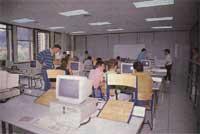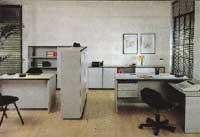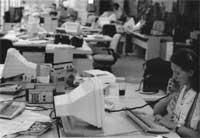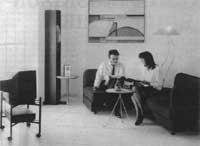Office pain
The modern offices are clean, bright, efficient. In them, the external pollution, like the mosaic, is totally iso (outside) by hermetically closed windows, the air conditioning keeps the temperature constant and the fluorescent evenly distribute their light clean. But something goes wrong. Those who work in it have the same symptoms (especially on Mondays): nervousness, depressions, apathy, in the psychological aspect; headache, excessive thirst and red or sore eyes, from the physiological point of view.

Management will say "little desire to work". The chief of staff will add the "Sunday hangover the next day." But, finally, the last minute investigations will give reason on this occasion to the sick worker, who is precisely the working environment the cause of the disease. "Siek building syndrome" is named after Doctor Anthony Pickering of the Wythen-Shawe Hospital in Manchester. All this had nothing to do with family debates, ulcers or heavy digestion.
As happens quite often in medical science, the discovery was somewhat random or random. The team that led Pickering was investigating the disease known as "wetting fever" (a kind of flu with high temperatures and respiratory distress), which usually appears in the offices with Spray air dryers and is aggravated after the weekend break and at the end of the working day. About twenty buildings began to conduct inspections, asking the staff.
The most curious thing was that, instead of finding data on the above-mentioned career of fire, he encountered a lot of much more common and widespread symptoms: with general dryness of the entire respiratory system and all kinds of headaches. Like an allergy that the Workplace would produce, disappeared or at least was quite streamlined at the return weekend. By far, it reappeared on Mondays with conventional force.
Although the syndrome is defined and accepted in some way, we still do not know, truly and truly, what are the direct causes. According to doctors, factors such as air conditioning, low ceilings, fluorescent lights or excessively high temperatures could be introduced.

The option seems clear at first glance. Make buildings more "healthy". But that, of course, has a high economic cost. The Americans, who are so fond of dollar calculations, have already paid off: the identification of pollutants (and their causes) in the "sick" environment is costly; one hundred billion pesetas per 1,000 m2 office. Includes losses due to office emptying, personnel transfers, weeks of investigation,...
It is no wonder that most companies resist the problem, and want to cover the problem with installing patches and paint layers to "improve the environment".
To the pathologies related to the working environment, the place and the air that is breathed, the uncomfortable or insufficient light and the materials used in the interior coatings must be added another pathology. No less important and increasingly widespread. We refer to the pathology associated with inadequate postures that occupy the spine (and especially the lumbar area) during working hours.
Spine, attacked spine
Around one hundred million workers are in the European Economic Union affected by low back pain and sacroneuralgia. Of these, almost 70% come from working conditions, influences or worsening. In the United States, spinal alterations are the main cause of permanent work incapacity in people under the age of forty and, along with cardiovascular diseases, the cost of US health is very high.
And even if it seems a lie, these types of mines have grown as jobs demanding physical efforts are reduced. No wonder those most affected are fans of new technologies. With hours and hours facing the screen in front of the computer terminal, the body takes static positions. And this position, according to experts, is a serious risk factor: our intervertebral disc lacks blood and, therefore, the ability to search for food and the elimination of catabolites or waste. Fixed positions thus prevent nutrition (exchange) and can facilitate long-term degenerative disk processes.

According to research (e.g. entrepreneurs!) good posture provides better performance at work. More or less specialized informative magazines usually advise on the most appropriate posture for the spine. And new gymnastic techniques, such as stretching, are aimed at correcting hardened muscles, especially lumbar muscles, by stretching. Although these factors are increasingly taken into account, perhaps those who design office furniture should be associated more with health rather than aesthetic design.
Technological barriers, new pathologies
The continued use of computer terminals, monitors and screens can cause eye injuries: visual fatigue, imitation and even corneal injuries. In fact, the same houses that make computers sell special filters and antibodies, which reduce reflections and contrast tones.
In the opinion of ophthalmologists, the main cause of eye fatigue (also usually there is long-term headache) is the constant movement of the look of the person working on the computer between the three objects located at different tancias dis (terminal, keyboard and work table). Thus, both one day and the next, every day, function as objectives that focus about thirty thousand times. As for lighting, experts recommend not to place lighting sources either in front or behind the screen (not even windows). Natural light should penetrate to the left and, if artificial, light should be sifted.
Some ahoberos have also mentioned the radiations emitted by these devices. However, according to reliable sources and research, there seems to be no danger in this regard. In the latest research conducted in Northern countries, the radiation dose emitted is biologically null.
However, another paper will delve into the incidence of computers in health.
Noise, tobacco and stress, executioners

After a year of work (200 working days of eight hours each), the dose of X-rays produced by the electron beam hit the inside of the screen barely reaches a million. And that amount is much lower than we received from the sun (80 million).
Another cause of the current concern is the so-called "noise pollution". According to a report prepared by the MOPU (Ministry of Public Works and Urbanism), the most serious problems arise within the industries, but the diffusion of this noise or noise to the surrounding areas, says the report, can cause environmental problems.
To this external noise is added the interior of the office: typewriters, boilers, photocopiers, bells, telephones, PA, motors,... The level can reach 90 decibels and this level, according to Dr. Annje Moch, is located in the risk atlas. Consequences, jackets, difficulty concentrating, progressive hearing loss, difficulty communicating orally,...
The hermeticism in these closed working environments seems, moreover, that the best known of all internal contaminations or contaminations, only influenced by personal factors, such as tobacco, facilitates.
Although there has been no hardness or virulence found in the U.S., a survey conducted at the EEC shows the following results in the survey conducted with a thousand inhabitants of the twelve countries: seven out of ten Europeans favor a significant increase in the price of tobacco, and eight out of ten have opted for reduced sizes for public premises (and the office is not a public venue? ). In our country, the benefits were 70% and 78% respectively.

In regular check-ups by some companies, it is increasingly common to diagnose smoking for those who have never smoked throughout their lives. They are known as passive smokers, since a recent seminar on cancer epidemiology held in Pamplona stated that the risk of cancer was 30% for these people who had been in the countryside.
Finally, we will mention another factor that greatly and decisively influences our work environment; psychological stress, which leads to organic attacks. Psychiatrists and psychologists define it as "an unstoppable hyperactivity situation that extends beyond what the forces themselves can." Almost all tensions have their origin in labor problems, and then they will generate conflicts and discussions within the family. In Spain it is estimated that this stress has exceeded three million people. "In Europe, more than 50 workers say this is due to fear of losing employment.
But we are within a "circle of witches." From this social system that forces us to work eight hours a day inside a hermetic cage arises another risk factor for our health: sedentary lifestyle, necessarily related to lack of physical exercise. And it is very rare that after that long list of risks that the sick worker assaults in the office, he goes home and wants to exercise. And that sedentary lifestyle behaves as another trigger in the progression of cardiovascular diseases.
XXI. 20th century: birth of a new medical specialty
Coatings, insulators, toxic substances, photocopiers, computer terminals, tubes fluors centésimas, air conditioning, heaters, carpets, air dust, excess environmental temperature, ... Headaches, visual disorders, painful joints and thorns, dizziness, vomiting and nausea, numerous catarros, allergies, respiratory congestion. All these symptoms do not have to be directly related to the "decoration" of the workplace, that is, with all the above mentioned agents, but the relationship between each other is very clear.
It is very possible that in the short term medicine has a new specialty (in which some doctors are already working) in which all the ills mentioned in this article are included. The company doctor should know very well the wide spectrum of pathologies caused by the "building disease syndrome" or the "closed zone syndrome". And your patients will start with: "I have office pain."





